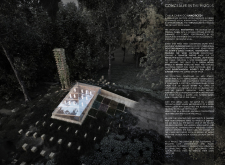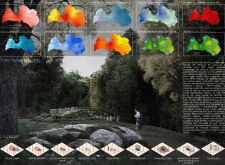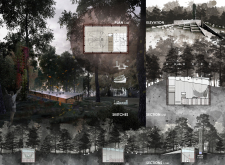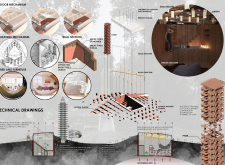5 key facts about this project
"Concealed in the Woods" is located in the Baltic region of Latvia. The design serves as a retreat, focused on blending with the surrounding forest. The concept emphasizes a connection with nature while reducing visual impact. This is achieved through modern architectural techniques that reflect traditional styles.
Strategic Integration
The cabin features a double-pitched roof that reimagines the typical form of a cabin. Most of the structure is sunk more than halfway underground, effectively minimizing disruptions to the landscape. This method allows the building to take advantage of the Earth’s consistent temperature, providing warmth in the winter and cooling in the summer. Wind exposure is greatly reduced, resulting in a comfortable living space year-round.
Material Subtlety
A quarter of the structure rises above ground and consists of reflective glass. This choice of material allows natural light to enter freely, while also offering broad views of the forest. During winter, the glass helps create a greenhouse effect, warming the cabin when the trees lose their leaves. In contrast, it provides softer, indirect light during the summer months. These features align with the goal of energy efficiency while maintaining a strong connection to the environment.
Living Connections
Central to the design is a totem-like structure that serves as a key element within the landscape. This component connects the cabin to its setting, supporting various plants that grow around it. Additionally, the totem channels water through its core, directing it to a buried and filtered tank linked to the cabin. This design emphasizes sustainable water management practices and reinforces the relationship with nature.
Ecological Considerations
Heating is achieved through a "hypocaust," a system inspired by ancient Roman baths. This method allows for heat to be distributed through the floors and walls, keeping the space warm during colder months. The design relies on lanterns for lighting, moving away from electrical sources. This choice encourages traditional methods that are sustainable and promote a deeper connection to the natural world.
The cabin’s exterior features reflective surfaces that mirror the surrounding landscape, enhancing the experience of living within the forest. This design approach not only creates a retreat but also fosters a daily engagement with nature.





















































